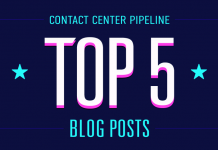
Customers are tired of being treated like numbers. They’re aware of how much of their information and feedback is being collected, and now consumers want the companies they do business with to use that data to provide a more personalized experience. According to a recent Accenture Pulse Check, 83% of consumers are willing to share their data to enable a personalized experience as long as: (1) businesses are transparent about how they are going to use the data, and (2) customers have control over it.
Personalization goes well beyond offering personal customer service. When delivering personal service, the focus is on a single interaction. Agents are trained to connect on a human level with callers, for instance, by using the caller’s name during the conversation, taking the time to listen with genuine empathy to the caller’s situation, and using details in the customer’s account or transaction history to demonstrate that the company knows who they are and that their business is valued.
A personalization strategy, on the other hand, leverages customer data and predictive modeling to uncover insights that allow you to anticipate your customers’ wants, needs and future service demands and guide decision-making. Personal customer service gives us those “wow” moments, whereas personalization can produce lasting change that makes the customer experience more proactive and efficient, produces better service outcomes, and increases customer retention and revenue.
In today’s era of the connected, empowered customer, expectations are high, and brand loyalty is increasingly fickle. According to Salesforce Research’s State of the Connected Customer, 76% of customers report that it’s easier than ever to take their business elsewhere, and they are willing to switch from brand to brand to find an experience that matches their expectations. When it comes to winning their business, customers cited the following as very important:
- 84% of customers want to be treated like a person, not a number
- 70% want brands to understand how they use products and services
- 59% want tailored engagement based on past interactions
Contact center management teams regularly dip into data collected through IVRs, ACDs, CRMs, call recordings, customer feedback and transactions primarily to identify opportunities for operational improvements and staff training. So how do you begin to tap into the insights that will transform your service delivery model from reactive to a more proactive, personalized approach?
Start with a Big Picture Goal

Many companies have been collecting customer data for years with no plans for what to do with it. “The most critical factor in making data-driven decisions is the planning part—you have to have a goal as to why you’re collecting the data,” says Jon Christiansen, Ph.D., a professor of data-mining courses at Charleston Southern University and Chief Intelligence Office of Ins & Outs, a data science firm specializing in machine learning, market research and customer experience optimization.
What does planning entail? Start by identifying the data that you have and where it comes from. Determine whether it’s a representative sample of your customer population. “Then consider how to cast it forward and create a vision for what that data is going to do,” Christiansen explains. “The instinct with data, especially in the contact center world, has been to focus on performance. But let’s talk big picture: How do we align what the company is trying to do overall with the user experience and the customer experience? If the vision is to make the customer experience effortless and make transactions easier, how are we integrating that into what we’re doing in the contact center? Once we know that, we can identify a few key things to improve and we can start collecting data on that.
“You don’t just want to collect data, which is what a lot of companies have done. You want to have a vision for what it’s going to do,” he says. “It needs to be aligned with planning and strategy to have any level of success.”
You Don’t Need to Be Amazon
The current buzz about predictive analytics and AI-powered solutions can make the way forward seem like a daunting journey. Industry articles, webinars and white papers stress the need to deliver an “Amazon-like experience,” and companies forge ahead with disappointing results.
“That is one of the roadblocks for many companies—they try to get too big and too sophisticated too fast, and in doing so, completely miss the target because they never set one,” Christiansen says. “We don’t need to become Amazon. We need to be great at what we’re great at, and then align that back to our goals, which are usually pretty simple and shouldn’t be difficult.”
The task doesn’t need to be difficult or intimidating, nor does it require advanced personalization tools. Christiansen points to the following example: By leveraging the data in its CRM system, a community college discovered that after a potential student had filled out an enrollment application, the applicant would call to inquire about financial aid generally within three to 15 days. This provided the college’s call center with the insight to more accurately predict call load during enrollment periods so that it could staff up and ensure that agents were trained to handle those call types.
Further, “insight from the predictive model revealed that, if we reached out to applicants within this magic window of three to 15 days, they were more likely to enroll. Those who fell outside of the window just didn’t show up,” Christiansen recalls. This enabled the call center to be proactive instead of waiting for applicants to call, which significantly boosted the college’s enrollment rate. In addition, the contact center was able to turn a complicated task, like filling out financial aid paperwork, into a more effortless experience for the students. “This was achieved by simply running a pivot table in Excel,” he points out.
For contact centers, next-problem resolution offers a practical and effective way to deliver a more proactive experience. By analyzing past complaints for patterns and applying a simple algorithm, companies can predict future problems that customers are likely to encounter. Providing that insight to frontline agents allows them to address those issues within the initial service call.
“This not only helps the customer to eradicate any potential issues and eliminates the next call, which increases the center’s efficiency,” Christiansen adds, “it also demonstrates to the customer that the company and agent actually care about solving that problem.”
Crossing the Line: Personalization and the Creepiness Factor
Consumers want a more personalized experience from the brands they do business with… but not too personalized.
Some brands’ attempts at personalization have crossed the line from helpful to invasive, according to Accenture’s Pulse Check: Making It Personal. Invasive approaches have included location- or browsing-based marketing tactics, such as:
- Getting a text from a brand or retailer when walking by a store (41% of conasumers find it creepy)
- Seeing ads on social media sites for items the consumer browsed on a brand website (35% of consumers find it creepy).
The price of getting personalization wrong is steep, according to Gartner’s 2018 State of Personalization Report, which found that more than half of consumers will unsubscribe from a company’s communications and 38% will stop doing business with a company if they find its personalization efforts to be too creepy.
“Creating personalized messages and experiences requires intimate knowledge of customer journeys, relevant content that drives action, and technology that helps deliver and measure experiences,” said Martha Mathers, managing vice president at Gartner. “Brands need to be extremely thoughtful in how they personalize their content today. Instead of utilizing every piece of customer data available, brands should focus on showing customers you can help them first, then layering in the right balance of data to boost message relevance, without making things too personal.”




